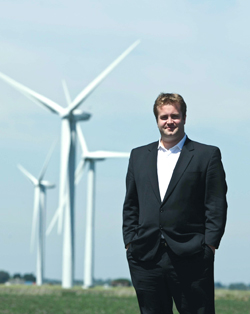 It’s easy to be impressed by a website that, after about a year of operation, draws more than 30,000 readers a month. But if the website in question taps into one of the country’s biggest challenges, that feat’s less surprising.
It’s easy to be impressed by a website that, after about a year of operation, draws more than 30,000 readers a month. But if the website in question taps into one of the country’s biggest challenges, that feat’s less surprising.
And that’s the case for BrighterEnergy.org, a news website run by James Cartledge, a British native who lives outside of York. Cartledge initially launched the site in January 2010, but he says it really took off after he got his green card in August. It garnered a bit more than 1,300 readers in February and, in December, reached more than 32,000. Not bad considering Cartledge generates most of the content by himself.
Cartledge, 32, may be new to the States, but he’s not new to writing about energy. The London native was a journalist in England, where he spent eight years covering the environment with a focus on recycling, energy and waste management. In 2008 he was the founding editor of a British website, NewEnergyFocus.com, but he says advertising income dropped off in the worldwide financial meltdown.
Across the pond
Cartledge met his wife while she was a fine-arts graduate student. The couple married a year and a half ago and received devastating news about a week after their honeymoon: Her mother had brain cancer.
So Cartledge and his bride moved to Pennsylvania to take care of her.
“She’s doing as well as can be expected,” he says.
BrighterEnergy.org gave him a project to work on in his new country. The idea for a similar site had been in his head for a while anyway, given the possibility that he would become one of the thousands of journalists out of a job. After moving here he went forward with his concept, combining his depth of experience covering energy issues and his new home in the U.S.
BrighterEnergy.org is filled with news items on projects ranging from a biodiesel supply deal with a Hawaiian utility to America’s first proposed offshore wind farm, near Cape Cod. It also features opinion pieces, stock market updates and a listing of jobs in green energy. Some readers get an e-mail newsletter, with most subscribers belonging to government agencies or the energy industry.
“We’ve got big debates going on in Congress and at the state level,” Cartledge says. “More and more people are seeing that they can put something on their roofs to make money. Solar panels can be a pension for a lot of people.”
Despite the time Cartledge has put into BrighterEnergy.org, it’s not the only beneficiary of his efforts. For what he calls his “day job” he freelances as a U.S. correspondent for a website that covers the postal industry. But he comes across quite a few energy-related stories there as well, given how many planes and cars are needed to get packages to their destinations. For that reason, the industry is taking steps like studying hybrid vehicles and designing delivery routes with fewer stops.
“Those guys are some of the biggest vehicle users in the world,” Cartledge says. “It’s a huge thing for these guys to cut down on their energy use.”
Plenty of potential
The U.S. has a lot of potential to embrace renewable energy sources, Cartledge says, but when it comes to embracing it we’re about a decade behind Europe. Americans generally like the idea of green energy sources, but every type has its drawbacks and specific projects often face opposition. Opponents point out concerns about lost animal habitats, among other things.
“Renewable energy is usually seen as a good thing, but it needs land,” Cartledge says. “It needs space.”
America’s real challenge, he says, is to commit the money toward green energy projects and make long-term plans to incorporate them into our power grids. Investors will only be willing to pour money into renewable energy if they’re convinced they’ll get their money back, and for that to happen there needs to be increased demand for power from these sources.
“The economic crisis, if you like, has made it very difficult to put the investment in,” he says. “Once you put the investment in, the energy is free.”
Still, Cartledge says renewable energy has a lot of potential in the U.S. He can see this country becoming a powerhouse in the solar energy industry, which was essentially invented here. And despite all the attention lavished on the Marcellus Shale formation, Pennsylvania has several energy sources beyond natural gas, he says. Biomass, wind and solar power could become important here if conditions permit.
“As a state, it’s got a lot of sunshine,” Cartledge says.
Rebecca VanderMeulen is a freelance writer who lives near Downingtown. As she tells friends out of state, that’s between the cheesesteaks and the Amish. Send feedback here.
To receive Keystone Edge free every week, click here.
